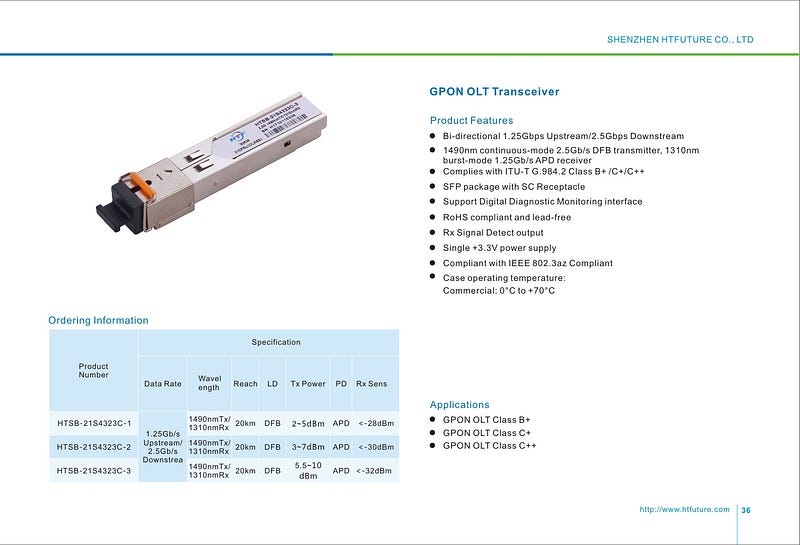PON ( Passive Optical Network) refers to the optical distribution network does not contain any electronic device and electronic power, optical distribution network (ODN) all by the optical splitter and other passive components, without the need for expensive electronic equipment, is a form of fiber-optic access network. PON reduces the amount of fiber and central office equipment required compared with point-to-point architectures.
A PON consists of an optical line terminal (OLT) at the service provider’s central office and a number of optical network units (ONUs) near end users. In OLT/ONU between the optical distribution network includes optical fiber and passive optical splitter or Fiber Optic Coupler.
OLT
An OLT, generally an Ethernet switch, router, or multimedia conversion platform, is located at the central office (CO) as a core device of the whole EPON system to provide core data and video-to-telephone network interfaces for EPON and the service provider.
ONU
ONUs are used to connect the customer premise equipment, such as PCs, set-top boxes (STBs), and switches. Generally placed at customer’s home, corridors, or roadsides, ONUs are mainly responsible for forwarding uplink data sent by customer premise equipment (from ONU to OLT) and selectively receiving downlink broadcasts forwarded by OLTs (from OLT to ONU).
ODN
An ODN consists of optical fibers, one or more passive optical splitters (POSs), and other passive optical components. ODNs provide optical signal transmission paths between OLTs and ONUs. A POS can couple uplink data into a single piece of fiber and distribute downlink data to respective ONUs.
There are two passive optical network technologies: Ethernet PON (EPON) and gigabit PON (GPON). EPON and GPON are applied in different situations, and each offers its own advantages in subscriber access networks. EPON focuses on FTTH applications while GPON focuses on full service support, including both new services and existing traditional services such as ATM and TDM.
EPON is a Passive Optical Network which carries Ethernet frames encapsulated in 802.3 standards. It is a combination of the Ethernet technology and the PON technology in compliance with the IEEE 802.3ah standards issued in June, 2004. A typical EPON system consists of three components: EPON OLT, EPON ONU and EPON ODN. It has many advantages, such as lower operation and maintenance costs, long distances and higher bandwidths.
GPON utilizes point-to-multipoint topology. GPON standard differs from other PON standards in that it achieves higher bandwidth and higher efficiency using larger, variable-length packets. And GPON is generally considered the strongest candidate for widespread deployments. GPON has a downstream capacity of 2.488 Gb/s and an upstream capacity of 1.244 Gbp/s that is shared among users.
There are also many differences between EPON and GPON. EPON, based on Ethernet technology, is compliant with the IEEE 802.3ah Ethernet in the First Mile standard that is now merged into the IEEE Standard 802.3–2005. It is a solution for the “first mile” optical access network. GPON, on the other hand, is an important approach to enable full service access network. Its requirements were set force by the Full Service Access Network (FASN) group, which was later adopted by ITU-T as the G.984.x standards–an addition to ITU-T recommendation, G.983, which details broadband PON (BPON).
Both EPON and GPON are accepted as international standards. They cover the same network topology methods and FTTx applications, incorporate the same WDM technology, delivering the same wavelength both upstream and downstream together with a third party wavelength. PON technology provides triple-play, Internet Protocol TV (IPTV) and cable TV (CATV) video services.

More information about HTFuture’s is available by emailing Ivy: sales6@htfuture.com
Skype: live:sales6_1683
Related Product
(1) Optical module (1.25G SFP, 10G XFP, SFP+, CWDM/DWDM, BIDI, 25G, 40G, 100G Module etc),
(2) Wavelength division multiplexer (WDM/CWDM/DWDM/OADM)
(3) Optical Transport Network Product (OEO, OTU, OBP, OLP, EDFA etc)

没有评论:
发表评论